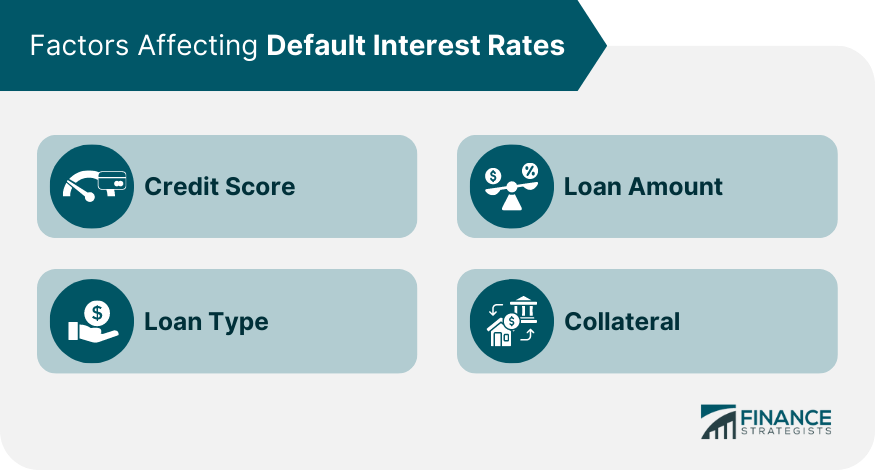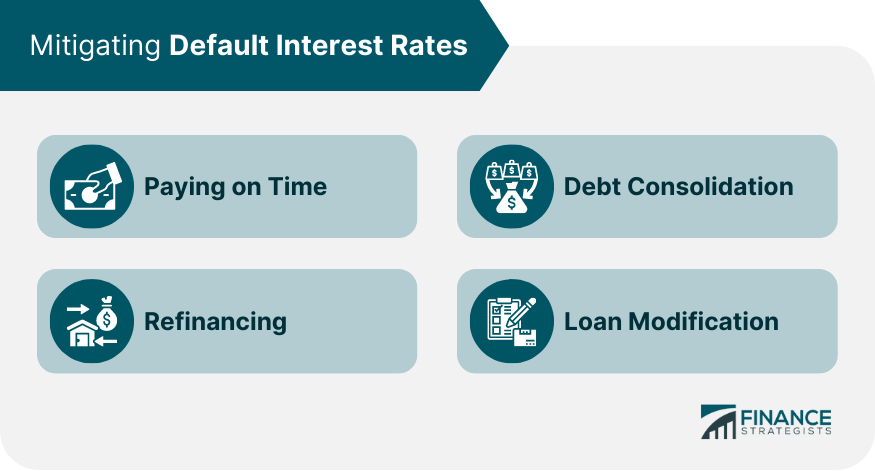Default interest rates are the additional fees charged by lenders to borrowers who fail to make timely payments on their loans. These rates are typically expressed as a percentage of the outstanding balance and can vary depending on several factors, including the type of loan, the amount borrowed, the borrower's credit score, and the collateral offered. The primary purpose of default interest rates is to compensate lenders for the increased risks and costs associated with late payments and defaults. Default interest rates are also a way for lenders to discourage borrowers from defaulting on their loans. Credit scores are one of the primary factors that determine default interest rates. A borrower's credit score reflects their creditworthiness, which is a measure of their ability to repay debts on time. Borrowers with higher credit scores are generally considered less risky and may be eligible for lower default interest rates than those with lower scores. On the other hand, borrowers with low credit scores may face higher default interest rates to compensate lenders for the increased risks associated with their loans. Different types of loans may have different default interest rates. For example, personal loans may have higher default interest rates than mortgages, as personal loans typically have shorter repayment periods and higher risks of default. Business loans may also have higher default interest rates than personal loans due to the higher risks associated with business lending. Loan amounts can also influence default interest rates. Generally, higher loan amounts may result in higher default interest rates, as lenders may view these loans as riskier due to the increased amount of money involved. The collateral offered by borrowers can also affect default interest rates. Collateral refers to the assets that borrowers pledge to secure their loans. Borrowers who offer high-value collateral, such as homes or cars, may be eligible for lower default interest rates as these assets can serve as a form of security for lenders in the event of default. Default interest rates are typically calculated as a percentage of the outstanding balance, based on the terms of the loan agreement. The formula for calculating default interest rates may vary depending on the lender's policies and the type of loan. One common formula for calculating default interest rates is: Default Interest Rate = Outstanding Balance x Default Interest Rate Percentage x Time For example, if a borrower has an outstanding balance of $10,000, and the default interest rate percentage is 5%, and the borrower is late for one month, the default interest rate would be: $10,000 x 5% x 1/12 = $41.67 This means that the borrower would need to pay an additional $41.67 in default interest for being late by one month. Default interest rates are typically included in loan agreements as part of the terms and conditions of the loan. Borrowers should carefully read and understand these agreements before signing them to avoid any surprises regarding the additional costs they may incur in case of late payments or defaults. State and federal laws regulate default interest rates to protect borrowers from unfair and abusive lending practices. These laws may limit the amount of default interest rates that lenders can charge or impose other restrictions on how they can apply them. Consumer protection laws also aim to protect borrowers from predatory lending practices and ensure that they are treated fairly and transparently. Borrowers should be aware of their rights under these laws and seek legal assistance if they suspect that they have been subject to unfair or deceptive lending practices. For borrowers, default interest rates can significantly increase the cost of borrowing and make it more difficult to repay their debts. Borrowers who fail to make timely payments or default on their loans may also suffer from damaged credit scores, making it more challenging to access credit in the future. For lenders, default interest rates can serve as a deterrent to borrowers who may default on their loans and compensate them for the increased risks and costs associated with late payments and defaults. However, lenders may also face additional costs associated with enforcing default interest rates, such as legal fees and collection costs. Default interest rates can also have wider economic impacts. Defaults and late payments can lead to loan losses for lenders, which can reduce their ability to lend and invest in other areas of the economy. Defaults can also contribute to financial instability and affect consumer confidence in the financial system. The best way to avoid default interest rates is to make timely payments. Borrowers should prioritize their loan payments and ensure that they have enough funds to cover them on time. Borrowers may be able to refinance their loans to lower their interest rates and monthly payments. Refinancing can also allow borrowers to consolidate multiple loans into one, making it easier to manage their debts. Debt consolidation involves taking out a new loan to pay off multiple debts, such as credit card balances and personal loans. Debt consolidation can simplify the repayment process and may result in lower interest rates and monthly payments. Borrowers who are struggling to repay their loans may be able to negotiate a loan modification with their lender. A loan modification can change the terms of the loan, such as the interest rate or repayment period, to make it more affordable for the borrower. Default interest rates are a necessary component of lending that serves to compensate lenders for the increased risks and costs associated with late payments and defaults. Borrowers must be aware of the factors that affect default interest rates, including their credit score, loan type, loan amount, and collateral. They must also take proactive measures to avoid default interest rates, such as paying on time, refinancing, debt consolidation, or loan modification. Lenders, on the other hand, must strike a balance between charging reasonable default interest rates and avoiding predatory lending practices that can harm borrowers and the economy as a whole. State and federal laws and consumer protection laws provide a framework to ensure that borrowers are treated fairly and transparently. In the end, understanding default interest rates and their implications is essential for both borrowers and lenders to manage risks, make informed decisions, and promote a healthy financial system.What Is a Default Interest Rate?
Factors Affecting Default Interest Rates
Credit Score
Loan Type
Loan Amount
Collateral

Calculation of Default Interest Rates
Legal Aspects of Default Interest Rates
Contractual Agreements
State and Federal Laws
Consumer Protection Laws
Impact of Default Interest Rates
Borrower's Perspective
Lender's Perspective
Economic Impact
Mitigating Default Interest Rates
Paying on Time
Refinancing
Debt Consolidation
Loan Modification

Final Thoughts
Default Interest Rate FAQs
The purpose of default interest rates is to compensate lenders for the increased risks and costs associated with late payments and defaults. They also serve as a deterrent to borrowers who may default on their loans.
Default interest rates are typically calculated as a percentage of the outstanding balance, based on the terms of the loan agreement. The formula for calculating default interest rates may vary depending on the lender's policies and the type of loan.
Borrowers may be able to negotiate default interest rates with lenders, especially if they are experiencing financial difficulties. However, lenders are not obligated to lower default interest rates and may have their own policies and procedures regarding renegotiating loan terms.
Default interest rates are typically included in loan agreements as part of the terms and conditions of the loan. State and federal laws regulate default interest rates to protect borrowers from unfair and abusive lending practices. Consumer protection laws also aim to protect borrowers from predatory lending practices and ensure that they are treated fairly and transparently.
Borrowers can avoid default interest rates by making timely payments, prioritizing loan payments, and ensuring that they have enough funds to cover them on time. They can also consider refinancing their loans to lower their interest rates and monthly payments, debt consolidation, or negotiating a loan modification with their lender.
True Tamplin is a published author, public speaker, CEO of UpDigital, and founder of Finance Strategists.
True is a Certified Educator in Personal Finance (CEPF®), author of The Handy Financial Ratios Guide, a member of the Society for Advancing Business Editing and Writing, contributes to his financial education site, Finance Strategists, and has spoken to various financial communities such as the CFA Institute, as well as university students like his Alma mater, Biola University, where he received a bachelor of science in business and data analytics.
To learn more about True, visit his personal website or view his author profiles on Amazon, Nasdaq and Forbes.











